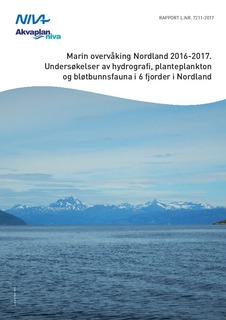Marin overvåking Nordland 2016-2017. Undersøkelser av hydrografi, planteplankton og bløtbunnsfauna i 6 fjorder i Nordland
Research report
Published version
Date
2017Metadata
Show full item recordCollections
- NIVA-rapporter [6992]
- Publikasjoner fra Cristin - NIVA [2149]
Abstract
Målsettingen er å overvåke og angi den økologiske miljøtilstanden i 6 ulike fjordområder i Nordland hvor det er en aktiv akvakulturnæring. 2016-2017 er det gjort undersøkelser i Sjona, Nordfoldfjorden, Sagfjorden, Tysfjorden, Ofotfjorden og Øksfjorden som har omfattet de to biologiske kvalitetselementene planteplankton (klorofyll a) og bløtbunnsfauna samt støtteparametere for disse. Rapporten omfatter resultater fra perioden fra juli 2016 til og med juni 2017 og gir en enkel omtale av resultatene. Bløtbunnsfauna fikk «god» tilstand (klasse II) på alle stasjonene, med unntak av Nordfoldfjorden som fikk «svært god» tilstand (klasse I). Innholdet av organisk karbon (TOC) i sedimentet var lavt, med unntak av Øksfjorden som hadde «svært dårlig» tilstand (klasse V) for organisk innhold i sedimentet. Planteplankton, gjennom klorofyll a, og næringssalter ga «Svært God» økologisk tilstand for stasjonene i Nordfoldfjorden, Tysfjorden, Sagfjorden, Ofotfjorden og Øksfjorden. En stasjon i Ofotfjorden får «god» økologisk tilstand som følge av høy klorofyll a-verdi. 2017-klassifiseringen for næringssaltene i sommerperioden omfatter kun data fra juni, og klassifiseringen av klorofyll a omfatter analyseresultater fra mars til og med juni. Foreliggende klassifisering for 2017 blir derfor ikke fullstendig siden den er basert på resultater til og med juni 2017, men den vil være fullstendig i neste rapportering fra overvåkingen. The aim of the surveys is to monitor and state the ecological environment in 6 different fjords in Nordland where there is an active aquaculture industry. In the years 2016-2017 investigations have been carried out in Sjona, Nordfoldfjorden, Sagfjorden, Tysfjorden, Ofotfjorden and Øksfjorden, which included the two biological quality elements phytoplankton (chlorophyll a) and soft-bottom fauna and supporting parameters for these. We are here reporting the period June 2016 – July 2017. The results from the study of soft sediment fauna showed that all sites had “good” environmental condition (Class II), except for the station in Nordfoldfjorden, which had “very good” condition (Class I). The quality element of soft sediment fauna thus meets the requirement of the water framework directive for at least good ecological status. However, the results showed low abundance of echinoderms and crustaceans, as well as moderate species diversity and abundances. The number of species and abundance has decreased compared with the survey in 2013. The organic carbon (TOC) content in the sediment was low and corresponded to “very good” (Class I) and “good” condition (Class II) on all the sites, except for Øksfjorden which had high organic carbon content in the sediment corresponding to “very poor” condition (class V). The biological quality element phytoplankton (chlorophyll a) and the supporting parameters nutrient salts, gave "very good" ecological status to the stations in the Nordfoldfjord, Tysfjord, Sagfjord, Ofotfjord and Øksfjord, One station in Ofotfjord showed "Good" ecological condition due to high values of chlorophyll a. It is important to point out that the 2017 classification for the nutrients during the summer period only includes data from June, and the calculations of P90 for the classification of chlorophyll a include results only from March through June. Therefore, the current classification for 2017 is tentative, but will be complete when more surveys have been accomplished.

